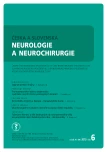Idiopathic Spinal Cord Herniation – a Case Report
Authors:
K. Saur 1; S. Ostrý 1; P. Vaněk 1; T. Belšan 2; V. Beneš 1
Authors‘ workplace:
ÚVN – Vojenská fakultní nemocnice Praha
Neurochirurgická klinika 1. LF UK, IPVZ
1; ÚVN – Vojenská fakultní nemocnice Praha
Radiologické oddělení
2
Published in:
Cesk Slov Neurol N 2013; 76/109(6): 740-744
Category:
Case Report
Overview
The authors present a case of a 38-year-old patient with progressive Brown-Séquard neurodeficit. Idiopathic spinal cord herniation at the spine level Th5 was identified as the main cause. Surgical reposition of the spinal cord and closure of the dural defect led to gradual clinical improvement. Improvement was observed in clinical as well as electrophysiological picture.
Key words:
spinal cord – herniation – Brown-Séquard syndrome – tethered cord syndrome
The authors declare they have no potential conflicts of interest concerning drugs, products, or services used in the study.
The Editorial Board declares that the manuscript met the ICMJE “uniform requirements” for biomedical papers.
Sources
1. Wortzman G, Tasker RR, Rewcastle NB, Richardson JC, Pearson FG. Spontaneous incarcerated herniation of the spinal cord into a vertebral body: a unique cause ofparaplegia – case report. J Neurosurg 1974; 41(5): 631 – 635.
2. Burgetová A, Kovářová I, Vaněčková M, Seidl Z. Posttraumatická transdurální herniace míchy – kazuistika. Cesk Slov Neurol N 2013; 76/ 109(1): 96 – 98.
3. Janda V. Funkční svalový test. Praha: Grada Publishing 1996 : 15.
4. Shin JH, KriShnaney AA. Idiopathic ventral spinal cord herniation: a rare presentation of tethered cord. Neurosurg Focus 2010; 29(1): E10.
5. Hassler W, Al ‑ Kahlout E, Schick U. Spontaneous herniation of the spinal cord: operative technique and follow‑up in 10 cases. J Neurosurg Spine 2008; 9(5): 438 – 443.
6. Nakamura M, Fujiyoshi K, Tsuji O, Watanabe K, Tsuji T,Ishii K. Long‑term surgical outcomes ofi diopathic spinal cord herniation. J Orthop Sci 2011; 16(4): 347 – 351.
7. Gwinn R, Henderson F. Transdural herniation of the thoracic spinal cord: untethering via a posterolateral transpedicular approach. J Neurosurg Spine 2004; 1(2): 223 – 227.
8. Watanabe M, Chiba K, Matsumoto M, Maruiwa H,Fujimora Y, Toyama Y. Surgical management of idiopathic spinal cord herniation: a review of nine cases treated by the enlargement of the dural defect. J Neurosurg Spine 2001; 95 (2 Suppl): 169 – 172.
9. Novak K, Wildham G, de Camargo AB, Perin N, Jallo G, Knosp E et al. The value of intraoperative motor evoked potential monitoring during surgical intervention for thoracic idiopathic spinal cord herniation. J Neurosurg Spine 2012; 16(2): 114 – 126.
Labels
Paediatric neurology Neurosurgery NeurologyArticle was published in
Czech and Slovak Neurology and Neurosurgery

2013 Issue 6
Most read in this issue
- Frontotemporal Lobar Degeneration from the Perspective of the New Clinical‑ Pathological Correlations
- Tuberous Sclerosis Complex in Children Followed from Neonatal Period for Prenatally Diagnosed Cardiac Rhabdomyoma – Two Case Reports
- Pineal Region Expansions
- Occipital Condyle Fractures
